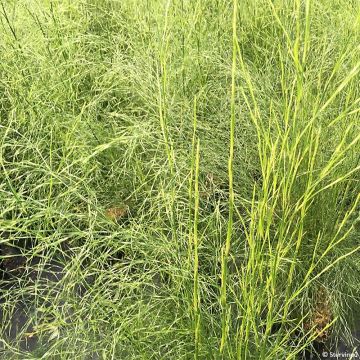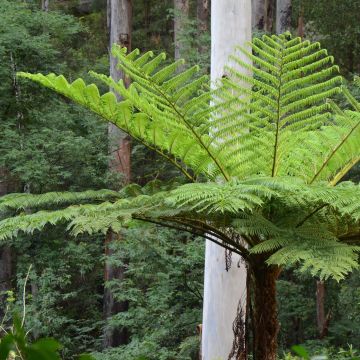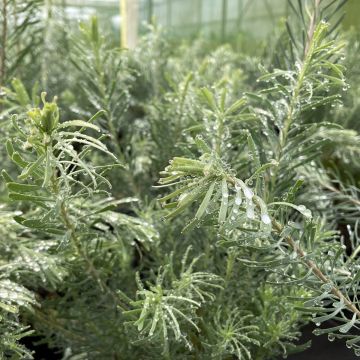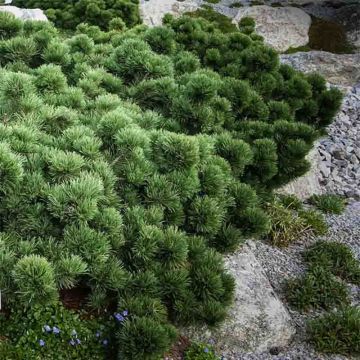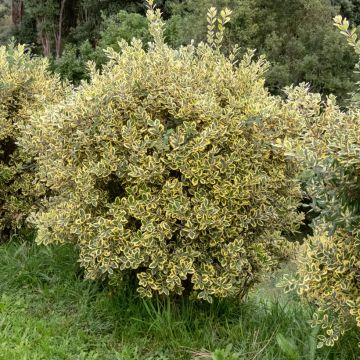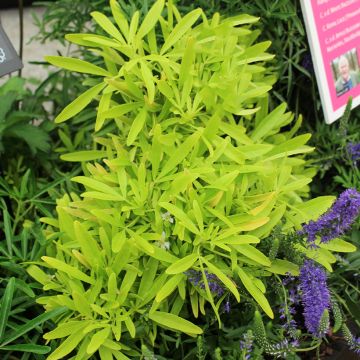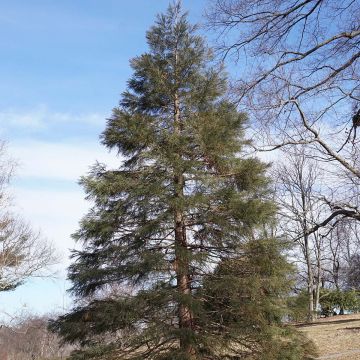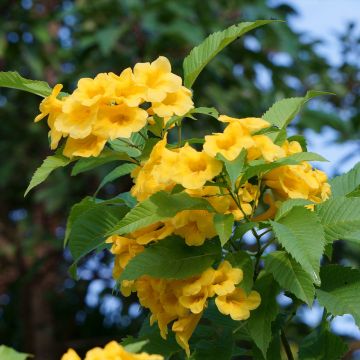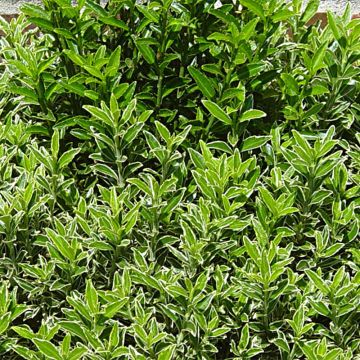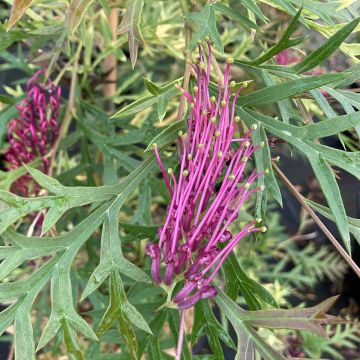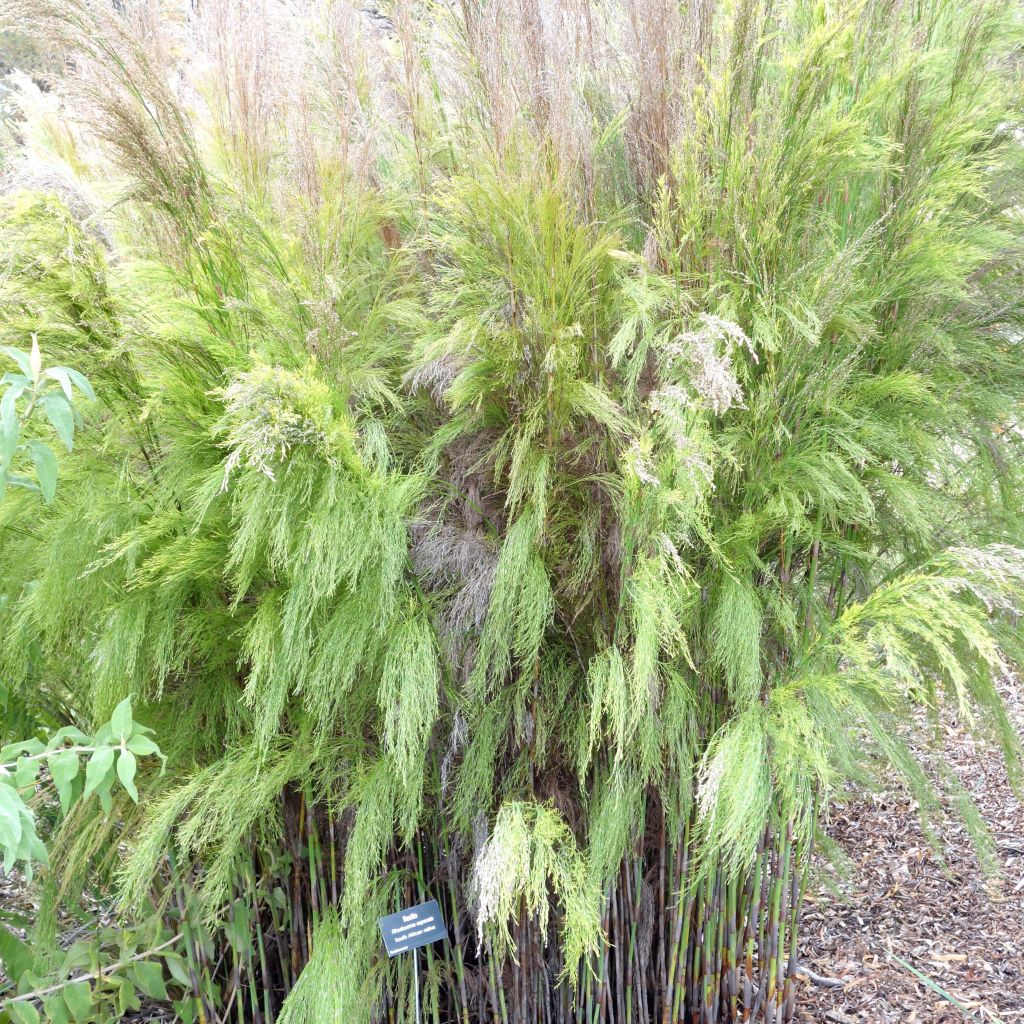

Rhodocoma capensis - Restio
Rhodocoma capensis
Rhodocoma capensis
Cape restio
This plant carries a 24 months recovery warranty
More information
We guarantee the quality of our plants for a full growing cycle, and will replace at our expense any plant that fails to recover under normal climatic and planting conditions.
From €5.90 for pickup delivery and €6.90 for home delivery
Express home delivery from €8.90.
Does this plant fit my garden?
Set up your Plantfit profile →
Description
The Rhodocoma capensis is a large perennial that resembles grasses, reeds or bamboo, originating from South Africa and Australia and commonly known as Restio. This one is one of the hardiest, most adaptable in cultivation, and also one of the most ornamental. It forms a large clump of flexible stems on which the foliage is replaced by many very fine branches, giving the plant an incredibly feathery appearance. Dense, flexible, airy, light green and vibrant, this plant is both beautiful and original and has its place in a dry, wild or contemporary-style garden. Let yourself be surprised and seduced by adopting it in a large container on the terrace or balcony!
The Rhodocoma capensis is a plant of the botany family Restionaceae. It is a robust, remarkably adaptable, and relatively hardy South African restio. In its country of origin, it can be found along roads and streams, in small pockets of soil between rocks, in loamy and cool soils, or in dry and warm ericaceous landscapes.
This large herbaceous perennial forms a clump of stems emerging from the base, tapering upwards. In three years, it will reach a height of 1.50m (5ft) with a 1m (3ft) diameter at the base, 1.50m (5ft) for the crown in open ground under favourable climates. The culms can reach 2m (7ft) in height after 5 to 7 years of cultivation. The plant develops flexible but sturdy stems with nodes like those on bamboo canes. Along these stems, at regular intervals, at the level of the nodes, there are clusters of feathery branches gathered in dense whorls. The stems are devoid of true leaves. At the end of each branch, brown flower heads appear. This plant is dioecious, meaning there are male and female plants. Flowering occurs in May-June, depending on the climate, in the form of long dark pink spikes in females and pale yellow-green in males, followed by the formation of capsules in females. In theory, it is evergreen, but the vegetation will be destroyed by frost, although a well-established plant will regrow from the stump in spring.
The Rhodocoma capensis is hardy down to -12 °C (10.4°F) in well-drained soil and protected by a thick mulch. This claim is supported by numerous French and British horticulturists who have tested this fantastic plant. Its bamboo-like and exotic silhouette, with large, vibrant green plumes, cannot fail to impress when glimpsed along a path or in the background of a border. Its extreme adaptability and hardiness allow it to be grown in open ground in many regions unaffected by severe frosts. It can be used decoratively on water edges, where it appreciates moist soil, and in much drier soil. It can also be used decoratively on a patio to be stored indoors in winter. It always pairs well with the astonishing Boronia, bamboo or Nandina, Dierama, Callistemon or even Gomphostigma virgatum, whether in open ground or a pot. Its flowers are gorgeous in dried bouquets.
Report an error about the product description
Rhodocoma capensis in pictures
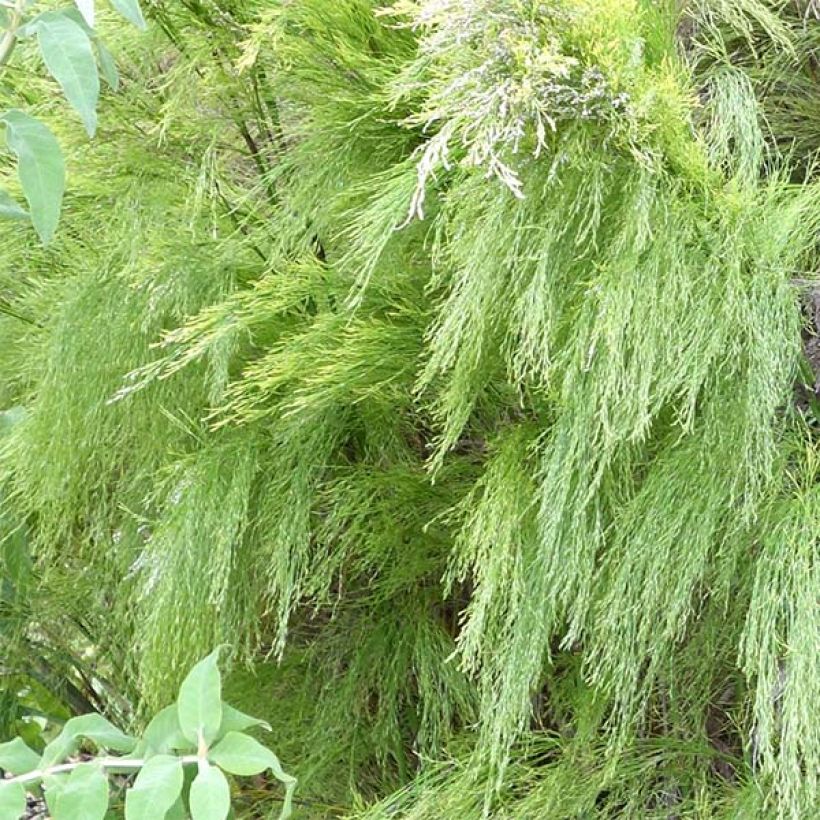

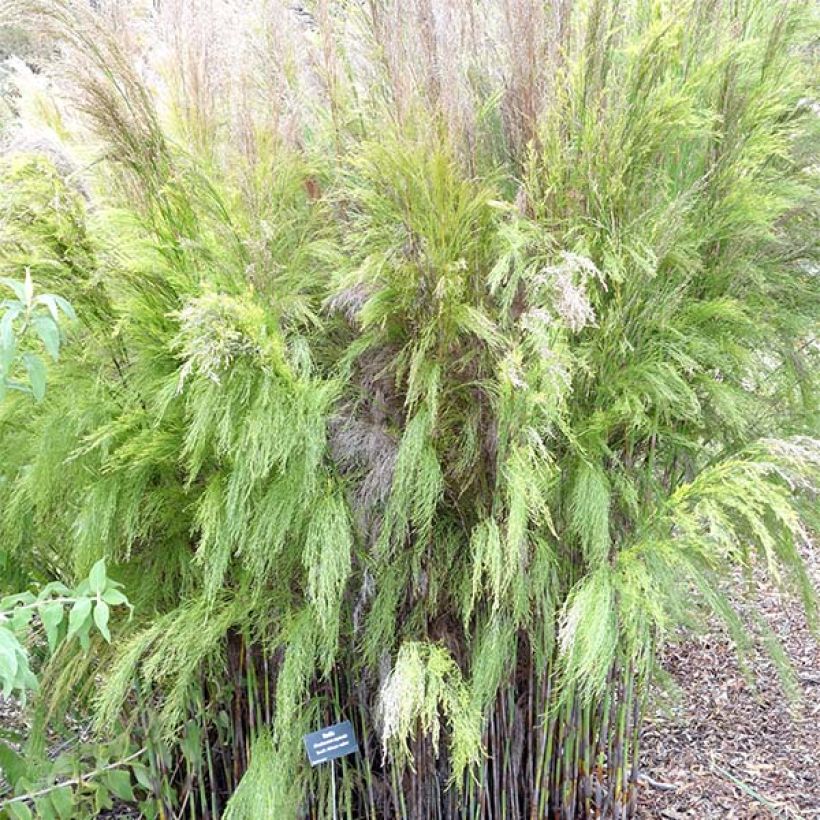

Plant habit
Flowering
Foliage
Botanical data
Rhodocoma
capensis
Restionaceae
Cape restio
South Africa
Other Restios
Planting and care
To plant the Rhodocoma capensis, choose a spot with well-drained soil that has been loosened. The plant is not picky about the type of soil, it can be clayey, rocky, silty, sandy, slightly chalky, or slightly acidic. Plant it in the spring after the last frost in cool regions, and in early autumn in warmer climates. It should be planted in a very sunny spot, or in light shade if necessary. In winter, protect the stump with a thick layer of mulch. The plant doesn't need much attention or maintenance. If you're planting it in a pot, make sure it has enough water and provide green plant fertiliser from spring to autumn. Dilute fertiliser in water and provide it once every 15 days.
It is propagated by dividing the clumps in spring.
Planting period
Intended location
Care
-
, onOrder confirmed
Reply from on Promesse de fleurs
Evergreen shrubs
Haven't found what you were looking for?
Hardiness is the lowest winter temperature a plant can endure without suffering serious damage or even dying. However, hardiness is affected by location (a sheltered area, such as a patio), protection (winter cover) and soil type (hardiness is improved by well-drained soil).

Photo Sharing Terms & Conditions
In order to encourage gardeners to interact and share their experiences, Promesse de fleurs offers various media enabling content to be uploaded onto its Site - in particular via the ‘Photo sharing’ module.
The User agrees to refrain from:
- Posting any content that is illegal, prejudicial, insulting, racist, inciteful to hatred, revisionist, contrary to public decency, that infringes on privacy or on the privacy rights of third parties, in particular the publicity rights of persons and goods, intellectual property rights, or the right to privacy.
- Submitting content on behalf of a third party;
- Impersonate the identity of a third party and/or publish any personal information about a third party;
In general, the User undertakes to refrain from any unethical behaviour.
All Content (in particular text, comments, files, images, photos, videos, creative works, etc.), which may be subject to property or intellectual property rights, image or other private rights, shall remain the property of the User, subject to the limited rights granted by the terms of the licence granted by Promesse de fleurs as stated below. Users are at liberty to publish or not to publish such Content on the Site, notably via the ‘Photo Sharing’ facility, and accept that this Content shall be made public and freely accessible, notably on the Internet.
Users further acknowledge, undertake to have ,and guarantee that they hold all necessary rights and permissions to publish such material on the Site, in particular with regard to the legislation in force pertaining to any privacy, property, intellectual property, image, or contractual rights, or rights of any other nature. By publishing such Content on the Site, Users acknowledge accepting full liability as publishers of the Content within the meaning of the law, and grant Promesse de fleurs, free of charge, an inclusive, worldwide licence for the said Content for the entire duration of its publication, including all reproduction, representation, up/downloading, displaying, performing, transmission, and storage rights.
Users also grant permission for their name to be linked to the Content and accept that this link may not always be made available.
By engaging in posting material, Users consent to their Content becoming automatically accessible on the Internet, in particular on other sites and/or blogs and/or web pages of the Promesse de fleurs site, including in particular social pages and the Promesse de fleurs catalogue.
Users may secure the removal of entrusted content free of charge by issuing a simple request via our contact form.
The flowering period indicated on our website applies to countries and regions located in USDA zone 8 (France, the United Kingdom, Ireland, the Netherlands, etc.)
It will vary according to where you live:
- In zones 9 to 10 (Italy, Spain, Greece, etc.), flowering will occur about 2 to 4 weeks earlier.
- In zones 6 to 7 (Germany, Poland, Slovenia, and lower mountainous regions), flowering will be delayed by 2 to 3 weeks.
- In zone 5 (Central Europe, Scandinavia), blooming will be delayed by 3 to 5 weeks.
In temperate climates, pruning of spring-flowering shrubs (forsythia, spireas, etc.) should be done just after flowering.
Pruning of summer-flowering shrubs (Indian Lilac, Perovskia, etc.) can be done in winter or spring.
In cold regions as well as with frost-sensitive plants, avoid pruning too early when severe frosts may still occur.
The planting period indicated on our website applies to countries and regions located in USDA zone 8 (France, United Kingdom, Ireland, Netherlands).
It will vary according to where you live:
- In Mediterranean zones (Marseille, Madrid, Milan, etc.), autumn and winter are the best planting periods.
- In continental zones (Strasbourg, Munich, Vienna, etc.), delay planting by 2 to 3 weeks in spring and bring it forward by 2 to 4 weeks in autumn.
- In mountainous regions (the Alps, Pyrenees, Carpathians, etc.), it is best to plant in late spring (May-June) or late summer (August-September).
The harvesting period indicated on our website applies to countries and regions in USDA zone 8 (France, England, Ireland, the Netherlands).
In colder areas (Scandinavia, Poland, Austria...) fruit and vegetable harvests are likely to be delayed by 3-4 weeks.
In warmer areas (Italy, Spain, Greece, etc.), harvesting will probably take place earlier, depending on weather conditions.
The sowing periods indicated on our website apply to countries and regions within USDA Zone 8 (France, UK, Ireland, Netherlands).
In colder areas (Scandinavia, Poland, Austria...), delay any outdoor sowing by 3-4 weeks, or sow under glass.
In warmer climes (Italy, Spain, Greece, etc.), bring outdoor sowing forward by a few weeks.

































